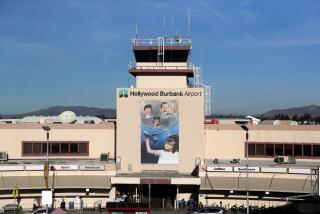Glorious old airports worth a fly-by
- Share via
People take airports for granted or, worse, abhor them, especially since the implementation of heightened security after the Sept. 11, 2001, terrorist attacks.
Not me. I still get as excited by the prospect of spending time in an airport as I was when I took my first flight at age 16.
I’ve also come to appreciate the aesthetic qualities of airports, many of which are the work of distinguished contemporary architects, such as Norman Foster, creator of state-of-the-art Chek Lap Kok in Hong Kong, and Renzo Piano, architect of Kansai airport, which is on an artificial island near Osaka, Japan.
Despite the downturn in the airline industry, amazing new airports continue to rise, including Barajas airport’s new terminal, a $1.6-billion project in Madrid designed by the Richard Rogers Partnership, which has also just unveiled a plan for London Heathrow’s Terminal 5.
At the same time, though, travelers are getting reacquainted with older, smaller airports used by budget start-ups, including New York-based JetBlue, which uses Long Beach for some of its Southern California flights, and Europe’s EasyJet, serving 55 cities across Britain and the Continent. The new guys keep ticket prices down by flying from secondary airports, where gate fees are relatively low.
Though some -- but not all -- of these low-cost-carrier terminals are farther from metropolitan areas than are the big hubs, travelers may find them easier to use and less congested.
Time, the advent of jumbo jets and a recent unfortunate party have made relics of many of these glorious older airports. Nevertheless, I have two favorites in this category: Eero Saarinen’s stunning Terminal 5, which opened in 1962 at New York’s John F. Kennedy airport, and stern, monumental Tempelhof in Berlin, created by Ernst Sagebiel in the late ‘30s for Nazi air minister Hermann Goering.
Terminal 5 at JFK, also known as the TWA Flight Center, is an aviation icon, created by the architect of the Gateway Arch in St. Louis and Dulles International Airport near Washington.
Architecture critics consider Dulles a better design because it proved expandable and is still functioning as a major airline hub. Terminal 5 was severely strained as airport traffic grew and technological demands mounted, resulting in its closure in 2001.
In August, JetBlue and the Port Authority of New York and New Jersey, which operates JFK, announced plans to reopen the Saarinen masterpiece as part of a new Terminal 5 to be built by the budget carrier. JetBlue expects to break ground next year, pending final approval by the Port Authority.
If you’re passing though JFK, it’s worth making the effort to see Terminal 5, as I did last month. This is easy to do by taking AirTrain, which links JFK’s nine terminals with nearby subway stations.
From the new train line’s elevated tracks, Terminal 5 looks singular against the backdrop of JFK’s architectural melange, like a raptor hovering over the tarmac, all fluid curves and swooping wings, with a beak-like porte-cochere. “It’s a magnificent piece of art in itself,” said Pasquale DiFulco, a spokesman for the Port Authority.
Unfortunately, Terminal 5’s immediate future was thrown into doubt recently when the opening of a modern art exhibition there in early October went disastrously awry. Inebriated guests broke open blocked-off passageways to the runways, painted graffiti on the walls and left the building like a trashed frat house, DiFulco said.
Though the Port Authority remains committed to reopening the historic building, the show was shut down and the doors were relocked, a pitiful coda to the Terminal 5 story.
The fate of Berlin’s Tempelhof is sad in its own way but a more positive commentary on respect for an architectural landmark, which it is by any estimation. Tempelhof was originally a Prussian parade ground and the scene of Germany’s first airplane flight and 1909 flight demonstrations by Orville Wright.
Adolf Hitler had it rebuilt along strictly symmetrical lines and on colossal proportions at the onset of World War II as part of making Berlin the capital of the Third Reich. Its crescent shape and flat rooftops allowed it to double as an amphitheater that could accommodate 100,000 spectators for celebrations of Nazi victories.
After the war, when the Soviets tried to drive out the Allies by blockading roads into West Berlin in 1948 and 1949, American forces under Gen. Curtis LeMay relayed 6,000 tons a day of crucial supplies into the city, via Tempelhof. Older residents remember candy dropped from the sky by American pilots.
Since the fall of the Berlin Wall 15 years ago, there have been at least two of everything in Berlin, including airports: Tegel, northwest of the city center, for international travelers, and Schonefeld, in the former East Germany, a modest little European budget airline hub. The city plans to phase out Tegel and expand Schonefeld.
Cash-strapped Tempelhof was scheduled to close at the end of October. A court order stopped that, ruling in favor of the handful of budget airlines that still call there. So the old Nazi showplace two miles south of the city center will continue to function, a fascinating architectural irony.
The tentative return of life to Terminal 5 at JFK and Tempelhof is an unexpected bonus for travelers, courtesy of the small budget carriers. I’m not sure which I like better: the low ticket prices or the airport architecture.
Susan Spano also writes “Postcards From Paris,” which can be read at www.latimes.com/susanspano.
More to Read
Sign up for The Wild
We’ll help you find the best places to hike, bike and run, as well as the perfect silent spots for meditation and yoga.
You may occasionally receive promotional content from the Los Angeles Times.






